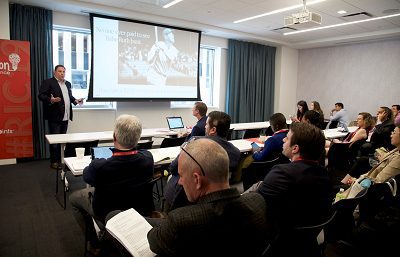The 2019 Retail Innovation Conference featured 24 breakout sessions organized into four tracks:
• Digital Strategies
• Operational Planning
• Marketing/Customer Engagement
• Omnichannel CX
These small-group sessions provided attendees with real-world retail examples, offering practical advice on hot topics including maximizing the value of pop-up stores, tapping the power of a customer community and integrating AR into the furniture shopper’s journey. Here’s a quick recap of the Digital Strategies and Operational Planning sessions; coverage of the remaining tracks will appear on June 3.
DIGITAL STRATEGIES
Next-Gen Pop-Ups: Instagrammable Moments, AR, Shoppable Showrooms
Before even choosing a location for a pop-up store, retailers should ask themselves what they would consider a successful outcome, according to Melissa Gonzalez, CEO, Lion’esque Group. The technology that goes into the pop-up store and the metrics used to measure activity there will differ depending on the retailer’s ultimate goals. Gonzalez also advised retailers to give pop-ups enough time to make an impact: “If you’re testing the viability of a market, take three months — certainly not less than one month. Otherwise there’s not enough opportunity to capture data.” One metric to keep an eye on is online sales: Dormify saw 2X to 2.5X growth in markets where it had established a pop-up store compared to other markets. “If you set up a store in the right geographic location and manage your costs well, online sees an outsize lift,” said Caren Sinclair-Kay, CEO of Dormify. Employees also are critical to a pop-up’s success: “Train the staff with more of a focus on hospitality than anything else,” said Matt Alexander, CEO, Neighborhood Goods.
Reshaping The Online Experience For The Shopper of the Future
As consumers increasingly embrace the ease and convenience of shopping online, retailers must be more creative in engaging shoppers via storytelling, especially now that consumer-facing AR, VR and 3D technologies are more widely available. Shrenik Sadalgi, Head of Next Gen Experiences at Wayfair, referred to today’s mobile devices as the “designer sitting in your pocket” that can serve as an immersive merchandising medium. “Think of the mobile evolution…draw that trajectory out as screens are getting smaller and computing interactions are getting a lot more natural,” Sadalgi said. “The next step is spatial computing. That means you’re doing the same things as before — checking emails, browsing web pages — but you’re doing it on your walls. Your ‘space’ becomes available in your shopping experience.” The expansion of this space will need to be the next investment frontier for retailers, especially as shoppers get comfortable with the idea of buying high-consideration products such as furniture and home improvement items online. “Let’s say you’re shopping for coffee tables,” said Sadalgi. “You’ll be able to see coffee tables across different web sites, pull them out into your space and literally compare them.”
The Community Pyramid At Rebecca Minkoff
Rebecca Minkoff wanted to “flip the pyramid” that had traditionally placed A-list influencers at the top and user-generated content (UGC) at the bottom. “The shift to put customers at the top is part of our move from a tech-first to a community-led brand,” said Sarah Sheldon, Senior Director of Global E-Commerce at Rebecca Minkoff. One of the most visible elements of this change has been the #IAmMany campaign, which focuses on female customers including filmmakers, STEM students and a singer/songwriter/activist. “With the theme of ‘We are many, and we are changing the world,’ our call to action was to have customers come into the store and write their own manifesto,” said Sheldon. The campaign’s results included 190 billion media impressions; a 344% year-over-year increase in online traffic; a 223% increase in demand sales via social channels; and a 4.14X conversion increase through the web site’s UGC stream.
How The Groomsman Suit Built A Multi-Million Dollar Company On A Little SEO And A Lot Of Customer Love
For The Groomsman Suit co-founders Diana Ganz and Jeanne Foley, “being a niche brand has paid off for us.” However, the retailer, which has sold high-quality male wedding wear for price points under $200 since 2016, is on a rapid growth path that may force it to leave the “niche” designation behind. The retailer’s success has come from a multi-pronged grassroots approach, including outreach to influencers and advocates such as wedding planners. “We would send samples to wedding planners for use in wedding magazines and blogs,” said Foley. “And at every wedding expo, we both got in front of engaged couples. Many expos gave us an opportunity because there are a lack of menswear brands there, and we were able to make direct contact with the grooms, which helped our web site traffic. At a wedding, their suit is the only thing the groom or groomsmen are allowed to touch, because the focus is so strongly on the bride.” The brand’s niche status also helped in its quest to build organic web site traffic with smart SEO, using tools including a blog featuring SEO-friendly keywords. “We’ve written hundreds of blogs, with topics like how the suit should fit, how to find the perfect pant leg and where to pin the boutonniere,” said Ganz. “We needed to get in front of the barriers that are in the buying path and build trust as a new brand.”
OPERATIONAL PLANNING
How To Build A Culture Of Happy Associates
A happy team is the precursor to retail success, not the result, according to Amanda Tygart, Program Manager for Data and Analytics at Walmart. She noted that high-performing teams need to be kept happy to truly achieve their full potential, and suggested that embracing charity and playfulness are good steps in achieving this goal. Raising money to help children or setting sales conditions that result in a manager taking a pie to the face are simple practices that keep employees engaged and make them feel invested in the company.
Driving Innovation By Doubling Down On Agility
Andy Laudato, EVP of CTO of Vitamin Shoppe, shared how the retailer has implemented Agile-at-scale practices within its business to improve organizational workflow and add genuine value to the customer experience. Some of the top talking points included: communicate with stakeholders more frequently; align on the fact that priorities will change; talk in broad themes rather than features; and remove specific dates from your product roadmap. Retailers must “fund teams, not projects,” and emphasize trust among employees and managers, he noted, adding “If you don’t have people you trust, don’t have them on the team…Netflix says that they have no place for brilliant jerks.” To improve communication, Laudato encouraged common calendars for WMS, POS, back office and CRM teams, so that all could understand everyone’s schedule. “I would cross-pollinate the teams. I would take people from each team and switch their jobs from a short time, and then you get empathy. The day you do it, both teams are worse. But in the long run, both teams are better.”
Inside The VC World: What Retailers Can Learn From Disruptive Brands
“Some of the best brands aren’t rocket ships,” noted Rachel Bentley, Co-Founder of The Citizenry, during her fireside chat with Dave Matthews of RevTech Ventures, an early investor in the brand. That’s especially true for The Citizenry, which has focused on growing and scaling in a practical way that still aligns with the brand’s core mission: to provide unique artisanal goods in the context of an ethical, transparent supply chain. “We wanted to focus on acquisition,” Bentley explained, “but we more so wanted to create an authentic experience and high-quality product.” Using data, Bentley found that the retailer’s core customers were highly concentrated in New York and California, so The Citizenry has experimented with pop-ups and events to better engage these local markets, as well as growing its online business and opening permanent brick-and-mortar stores.
Financial Analyst Panel: Navigating Retail Growth In An Uncertain Economy
Political forces and economic performance play a crucial role in not only how consumers shop but in the ways retailers invest and innovate in their business, according to a panel of financial experts. For example, Mickey Chadha, VP & Senior Credit Officer at Moody’s, hasn’t noticed a negative impact from the China tariffs because “companies in the apparel space have been able to shift their strategies rather quickly.” However, should the tariff rate increase, “smaller players will be disadvantaged due to forced price increases.” Panelists also noted that store growth remains a challenge, as many retailers have over-expanded in brick-and-mortar. They advised retailers to focus on expanding their e-Commerce and omnichannel capabilities. “The best model we see is brick-and-mortar complemented by e-Commerce,” Chadha advised. “Retailers have to seamlessly integrate those channels in order to make money.”













